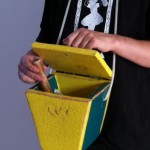 Have you ever noticed that many simple musical instruments are also perfect for teaching shapes?
Have you ever noticed that many simple musical instruments are also perfect for teaching shapes?
This week, while doing a preschool program, one of the quieter young boys became very excited about naming the shapes of the instruments we were making and playing. He noticed the washboard he loved to play was in the shape of a rectangle. And his sister had a tambourine that was shaped like the moon! The other kids enjoyed the idea and pretty soon, we had gone through an entire basket of instruments finding all types of shapes in all kinds of different ways.
 For instance, how many circles can you find in the instruments to the right? We counted 12!
For instance, how many circles can you find in the instruments to the right? We counted 12!
And what shapes are here in the tambourines and triangle below?
What a fun way to combine music and some of the basic skills that will help a child excel in school or in their homeschool learning.
 Don’t have a basket of instruments around your home?
Don’t have a basket of instruments around your home?
No worries, here are some simple musical crafts that will have you not only putting a circle in the square – but playing one, too!
SQUARES AND RECTANGLES
Make a Cajón Box Drum
Free from DARIA’s website
http://www.dariamusic.com/docs/MYO%20Cajon.pdf
Free from TPT
https://www.teacherspayteachers.com/Product/The-Cajon-Make-And-Play-Your-Own-Box-Drum-1236616
Square Ocean Drum http://www.dariamusic.com/docs/Ocean%20Drum%20Instructions.pdf
CIRCLE
Bongo Drums
https://www.teacherspayteachers.com/Product/Make-And-Play-Your-Own-Bongo-Drums-1430615
 Button Castanets
Button Castanets
https://www.teacherspayteachers.com/Product/Make-Your-Own-Button-Castanets-1439711
Chinese Gong
http://www.dariamusic.com/docs/chinesegong.pdf
https://www.teacherspayteachers.com/Product/Make-Your-Own-Chinese-Gong-From-Recycled-Materials-486935
Triangle
 Egyptian Rattle http://www.dariamusic.com/docs/naturalsistrum.pdf
Egyptian Rattle http://www.dariamusic.com/docs/naturalsistrum.pdf
Explore More
Can you think of more simple shapes that are found in instruments? Let us know and we’ll feature them here!
Find lots more DIY/MYO Crafts on Daria’s website craft and activity page:
http://www.dariamusic.com/crafts.php
Or her TeachersPayTeachers Store:
https://www.teacherspayteachers.com/Store/Daria-Marmaluk-Hajioannou









